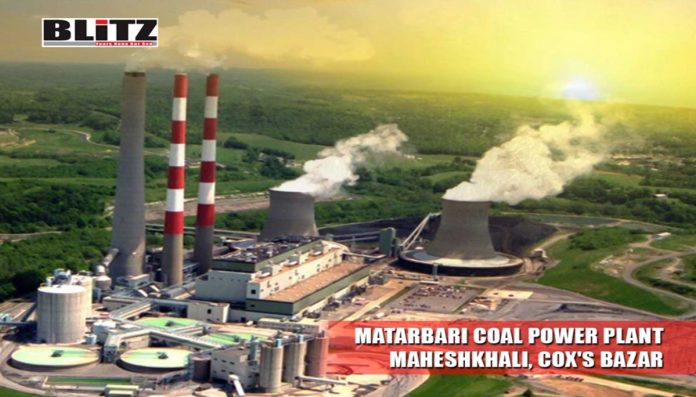The approval for this coal power plant, Bangladesh’s largest at 1,200 megawatts, came in 2014. It was constructed on the 1,600-acre abandoned salt field in Matarbari, Cox’s Bazar’s Maheshkhali upazila. The construction cost amounted to about Tk. 519.84 billion, with Japan’s development agency JICA providing around Tk. 439.21 billion. The remaining Tk. 79.33 billion was sourced from the Bangladesh Government and the Coal Power Generation Company Bangladesh Limited (CPGCBL).
Matarbari Coal Power Plant Project stands as one of the government’s priority fast-track mega projects. Under the Coal Power Generation Company Bangladesh Limited (CPGCBL), the power plant’s construction is underway. CPGCBL entered into an agreement with a consortium of three Japanese companies, including Toshiba Corporation, in July of the preceding year, for the plant’s construction. Per the contract terms, completion of the power plant’s construction was scheduled for December 2023.
According to the plan, the first 600 MW unit is slated for commercial production in January 2024, followed by another 600 MW unit in July of the same year.
Meanwhile, a pressing concern is the Matarbari coal power plant’s outstanding debt of Tk. 7.00 billion to the government. The plant currently holds coal reserves for the next three months. However, if the outstanding amount isn’t settled promptly, coal imports could be halted, affecting the plant’s operations.
Currently, two units at the center are operational. The first unit has been officially inaugurated, while the second is undergoing trial runs. Chittagong faces electricity supply shortages due to the incomplete substation preparation. However, electricity prices from Matarbari are lower compared to other coal-based centers. The project is overseen by the government organization Coal Power Generation Company Bangladesh Limited. Recent discussions with multiple officials at the Matarbari coal power plant have unveiled several concerning issues.
Engineer Abul Kalam Azad, the managing director of Coal Power Generation Company Bangladesh Limited, highlighted in a media interview that the government is owed Tk. 7.00 billion from electricity sales. He emphasized the plant’s current coal reserves, which can last for three to four months. Azad mentioned that they have initiated international tenders for coal imports. However, if the outstanding amount isn’t settled promptly, it could hinder the coal import process.
Engineer Azad further stated that the second unit’s official launch is scheduled for next June. He pointed out that the Madunaghat sub-centre isn’t fully operational yet, affecting its ability to receive full power. As a result, half of the electricity generated is redirected to the Meghnaghat sub-centre.
According to the concerned officials of the power plant, both units, each with a capacity of 600 MW, are currently operational. The maximum daily power supply from the center has reached 800 MW. While the center is prepared for power generation and distribution, it is not yet fully operational. Consequently, half of the electricity generated is being directed to Chittagong’s Madunaghat sub-centre, with the remainder allocated to Narayanganj’s Meghnaghat sub-centre.
They explained that the installation of transformers at the Madunaghat sub-centre remains incomplete and is expected to conclude in May. Consequently, Matarbari cannot absorb all the electricity generated, leading to an inability to meet Chittagong’s demand. Therefore, the surplus electricity is diverted to the Meghnaghat sub-centre.
The concerned officials additionally noted that the electricity price per unit in Matarbari is lower compared to other coal-based centers across the country. While electricity costs range from 10 to 12 taka per unit in other centers, Matarbari consumes only 8 taka per unit. The plant sources its coal from Indonesia, with a combustion or calorific value ranging between 4,200 to 5,000.
Experts associated with the power plant affirmed that both low-quality and high-quality coal can be utilized in the facility. They highlighted the implementation of multiple purification levels to mitigate environmental pollution, ensuring that the plant does not pose any harm to the environment.
Noted that, A loan agreement was signed between the Government of Bangladesh and the Japan International Development Agency (JICA) on June 16, 2014. The agreement stipulated that the project would incorporate state-of-the-art features, including an imported coal load-unload jetty, a power generation plant, a township, electrification of local areas, and the construction of power transmission lines and connecting roads for the power plant.
The project authority for the coal power plant has undertaken comprehensive infrastructure development to facilitate coal transportation and storage. They have constructed jetties and silos specifically designed for these purposes. The silo boasts an impressive capacity, capable of storing coal to sustain the plant’s operations for up to 60 days. Additionally, the jetty is designed to accommodate a mother vessel with a coal capacity of 80 thousand tons. This vessel can dock efficiently at the jetty, and the unloading process typically takes between one to two days.
However, there is a significant dependency on timely financial support from the government. If the due payments are delayed or not received as scheduled, it could jeopardize the import of coal. Such disruptions in coal supply would inevitably lead to interruptions in the power generation process, impacting the plant’s ability to produce electricity efficiently and reliably. Therefore, ensuring timely financial disbursements is crucial to maintaining the seamless operation of the coal power plant and meeting the region’s energy demands.




